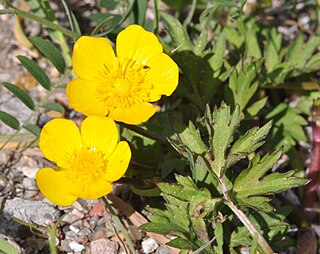
Botany, also called plant science, plant biology or phytology, is the science of plant life and a branch of biology. A botanist, plant scientist or phytologist is a scientist who specialises in this field. The term "botany" comes from the Ancient Greek word βοτάνη meaning "pasture", "herbs" "grass", or "fodder"; βοτάνη is in turn derived from βόσκειν, "to feed" or "to graze". Traditionally, botany has also included the study of fungi and algae by mycologists and phycologists respectively, with the study of these three groups of organisms remaining within the sphere of interest of the International Botanical Congress. Nowadays, botanists study approximately 410,000 species of land plants of which some 391,000 species are vascular plants, and approximately 20,000 are bryophytes.

Flowering plants are plants that bear flowers and fruits, and form the clade Angiospermae, commonly called angiosperms. They include all forbs, grasses and grass-like plants, a vast majority of broad-leaved trees, shrubs and vines, and most aquatic plants. The term "angiosperm" is derived from the Greek words ἀγγεῖον /angeion and σπέρμα / sperma ('seed'), meaning that the seeds are enclosed within a fruit. They are by far the most diverse group of land plants with 64 orders, 416 families, approximately 13,000 known genera and 300,000 known species. Angiosperms were formerly called Magnoliophyta.

Sex is the trait that determines whether a sexually reproducing organism produces male or female gametes. Male organisms produce small mobile gametes, while female organisms produce larger, non-mobile gametes. Organisms that produce both types of gametes are called hermaphrodites. During sexual reproduction, male and female gametes fuse to form zygotes, which develop into offspring that inherit traits from each parent.

Robert Anthony Plant is an English singer and songwriter. He was the lead singer and lyricist of the rock band Led Zeppelin from its founding in 1968 until their breakup in 1980; since then he has had a successful solo career, sometimes collaborating with other artists such as Alison Krauss. Regarded by many as one of the greatest singers in rock music, he is known for his flamboyant persona and raw stage performances.

The jalapeño is a medium-sized chili pepper pod type cultivar of the species Capsicum annuum. A mature jalapeño chili is 5–10 cm (2–4 in) long and hangs down with a round, firm, smooth flesh of 25–38 mm wide. It can have a range of pungency, with Scoville heat units of 4,000 to 8,500. Commonly picked and consumed while still green, it is occasionally allowed to fully ripen and turn red, orange, or yellow. It is wider and generally milder than the similar Serrano pepper.
In genetics, an expressed sequence tag (EST) is a short sub-sequence of a cDNA sequence. ESTs may be used to identify gene transcripts, and were instrumental in gene discovery and in gene-sequence determination. The identification of ESTs has proceeded rapidly, with approximately 74.2 million ESTs now available in public databases. EST approaches have largely been superseded by whole genome and transcriptome sequencing and metagenome sequencing.

The family Campanulaceae, of the order Asterales, contains nearly 2400 species in 84 genera of herbaceous plants, shrubs, and rarely small trees, often with milky sap. Among them are several familiar garden plants belonging to the genera Campanula (bellflower), Lobelia, and Platycodon (balloonflower). Campanula rapunculus and Codonopsis lanceolata are eaten as vegetables. Lobelia inflata, L. siphilitica and L. tupa and others have been used as medicinal plants. Campanula rapunculoides may be a troublesome weed, particularly in gardens, while Legousia spp. may occur in arable fields.

A flower, sometimes known as a bloom or blossom, is the reproductive structure found in flowering plants. Flowers produce gametophytes, which in flowering plants consist of a few haploid cells which produce gametes. The "male" gametophyte, which produces non-motile sperm, is enclosed within pollen grains; the "female" gametophyte is contained within the ovule. When pollen from the anther of a flower is deposited on the stigma, this is called pollination. Some flowers may self-pollinate, producing seed using pollen from the same flower or a different flower of the same plant, but others have mechanisms to prevent self-pollination and rely on cross-pollination, when pollen is transferred from the anther of one flower to the stigma of another flower on a different individual of the same species.
The RNAi Consortium, or TRC, is a public-private partnership whose mission is to create libraries of small hairpin RNAs (shRNAs) for 15'000 human and 15'000 mouse genes. These libraries should help the scientific community to analyse gene function by RNAi. The consortium is based at the Broad Institute of the MIT and Harvard University, and includes 6 MIT- and Harvard-associated institutions and 5 international life sciences organizations. Verified RNAi clones and entire libraries are made available both by Sigma-Aldrich and Open Biosystems.
Unigene Laboratories (OTC:UGNE) was a biopharmaceutical company, engaged in the research and development of peptides for medical purposes. The company was founded in 1980 and is located in New Jersey.

Plants are the eukaryotes that form the kingdom Plantae; they are predominantly photosynthetic. This means that they obtain their energy from sunlight, using chloroplasts derived from endosymbiosis with cyanobacteria to produce sugars from carbon dioxide and water, using the green pigment chlorophyll. Exceptions are parasitic plants that do not contain chlorophyll, and obtain their energy from other plants.

Carbohydrate kinase domain containing protein, encoded by CARKD gene, is a human protein of unknown function. The CARKD gene encodes proteins with a predicted mitochondrial propeptide (mCARKD), a signal peptide (spCARKD) or neither of them (cCARKD). Confocal microscopy analysis of transfected CHO cells indicated that cCARKD remains in the cytosol, whereas mCARKD and spCARKD are targeted to the mitochondria and the endoplasmic reticulum respectively. The protein is conserved throughout many species, and has predicted orthologs through eukaryotes, bacteria, and archea.

MALSU1 is a gene on chromosome 7 in humans that encodes the protein MALSU1. This protein localizes to mitochondria and is probably involved in mitochondrial translation or the biogenesis of the large subunit of the mitochondrial ribosome.
UgMicroSatdb is a database of microsatellites present in uniGene.

Protein KIAA1958 is a protein that in humans is encoded by the KIAA1958 gene. Orthologs of KIAA1958 go as far back in evolution to chordates, although, it is closer in homology to primates than any other orthologs. KIAA1958 has no known paralogs.
L-allo-threonine aldolase is an enzyme catalyzing the conversion between L-allothreonine on one side and glycine plus acetaldehyde on another side. Artificial disabling (knockout) of this enzyme in wild bacteria has no significant effect. However such disabling suppresses the growth of mutants that already lack other enzyme, serine hydroxymethyltransferase. Hence L-allo-threonine aldolase provides the alternative pathway for cellular glycine when serine hydroxymethyltransferase is inert. E.coli L-allo-threonine aldolase is a highly termostable enzyme, this can be used for purification.
Function Maize gene for first step in biosynthesis of benzoxazin, which aids in resistance to insect pests, pathogenic fungi and bacteria.

C3orf70 also known as Chromosome 3 Open Reading Frame 70, is a 250aa protein in humans that is encoded by the C3orf70 gene. The protein encoded is predicted to be a nuclear protein; however, its exact function is currently unknown. C3orf70 can be identified with known aliases: Chromosome 3 Open Reading Frame 70, AK091454, UPF0524, and LOC285382.
Trilochan Mohapatra is an Indian biotechnologist, geneticist, former government secretary of the Department of Agricultural Research and Education (DARE) and former director general of the Indian Council of Agricultural Research. Known for his studies in the fields of molecular genetics and genomics, Mohapatra is an elected fellow of the National Academy of Sciences, India, the National Academy of Agricultural Sciences, the Indian National Science Academy and the Indian Society of Genetics and Plant Breeding. The Department of Biotechnology of the Government of India awarded him the National Bioscience Award for Career Development, one of the highest Indian science awards, for his contributions to biosciences in 2003.

Euphorbia virgata, commonly known as leafy spurge, wolf's milk leafy spurge, or wolf's milk is a species of spurge native to Europe and Asia, and introduced in North America, where it is an invasive species.












